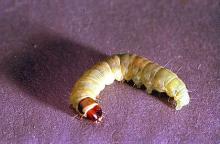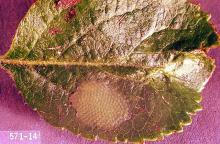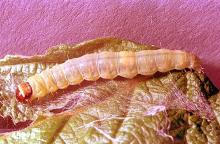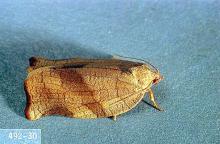Fruittree leafroller (Archips argyrospila)
Obliquebanded leafroller (Choristoneura rosaceana)
Pest description and crop damage There are several species of leafroller and leaftier pests of Malus. These are larvae of several moth species, which use native plants as hosts as well as fruit trees. They all cause similar damage to the trees but differ in their appearance and, more importantly, in their life cycle. The principal leafroller pests can be divided into single-generation moths, such as the fruittree leafroller and the European leafroller; and two-generation moths, such as the obliquebanded leafroller and threelined leafroller. Adults of these species are variable in color, ranging from fawn-colored to dark brown. There are distinctive bands or mottling on the wings. Wing spans range from 0.5 to 1 inch. The larvae of these species are all green caterpillars with a light brown to black head, depending on species. Leaftiers are similar in appearance, although larvae are up to 0.5 inch long, dirty white, with a brownish head.
As the name leafroller or leaftier implies, the larvae roll and tie leaves together for shelter and feeding. Leafroller larvae thrash about violently when disturbed, and may drop from the leaf suspended by a silken thread. The larvae web leaves and flowers together and feed on and tunnel into the unripe and ripe fruit. Feeding on growing points on young plants can promote undesirable branching. Larvae also feed on the surface of the fruit, causing deep, russetted scars.
Biology and life history The single-generation leafrollers overwinter as egg masses on twigs and branches. Eggs hatch in spring as buds are opening, and hatch is completed by petal fall. The larvae feed for 4 to 6 weeks, then pupate in the rolled leaves and emerge as moths in early summer. The overwintering eggs are laid in July. Two-generation leafrollers overwinter as immature larvae under the bark on scaffold branches of a variety of host plants. Larvae may feed during warm periods in winter, but become active in spring with onset of new growth. They feed for several weeks, then pupate in rolled leaves. Adult moths emerge in late April-May. These lay eggs for the next generation. The next generation hatches in early summer and does the most damage.
Leaftiers overwinter in silken cases as young larvae on bark of trees and other rough surfaces. In spring, the larvae spin silken threads and are carried by wind to host plants. The larvae web the leaves and flowers together beginning in late April, then feed on the developing fruit. The moths appear in June and July and lay eggs. There is one generation per year.
Scouting and thresholds Observe early spring growth for rolled leaves and feeding damage on new growth.
Management-biological control
See:
Biological Control of Nursery Pests
Very low temperatures in winter significantly reduce overwintering populations of larvae. Spiders and parasitic wasps, as well as predators like the brown lacewing, greatly reduce leafroller populations throughout the year.
Management-cultural control
Hand-pick rolled leaves containing larvae or pupae. Removal of overwintering sites, such as rolled leaves on the ground or plastered to trees, can reduce next year's population.
Management-chemical control
See:





